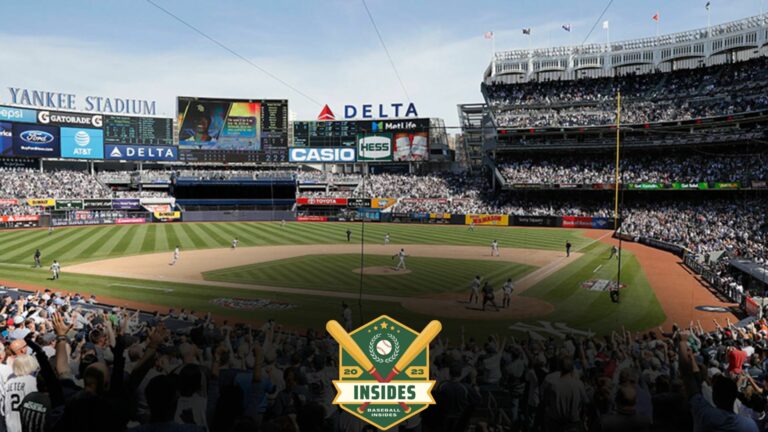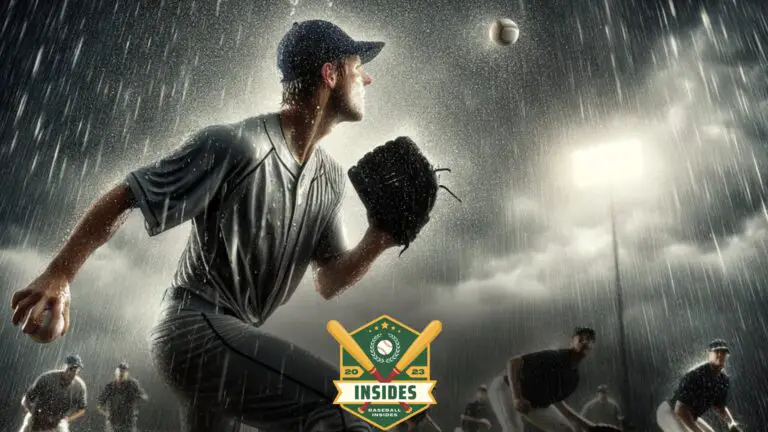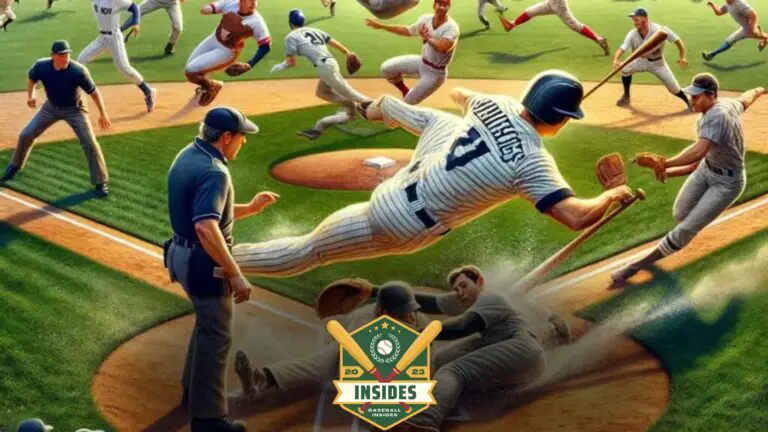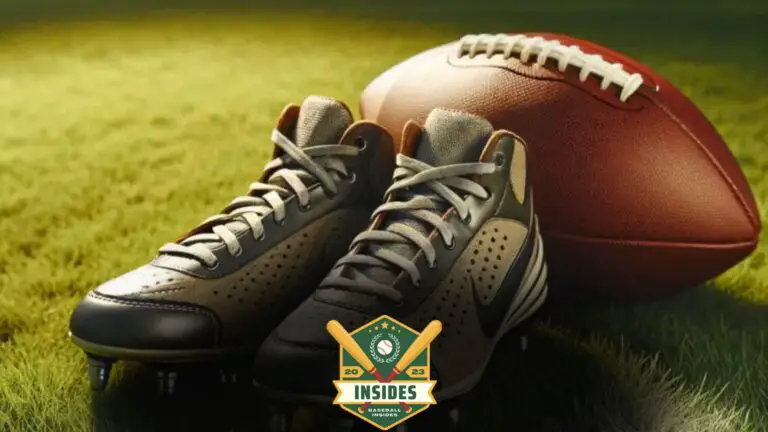
In this article:
Your son can wear football cleats for baseball, but it’s not ideal. Baseball cleats are specifically designed for the sport’s movements.
Choosing the right footwear for your child’s sports activities is crucial for safety and performance. While football cleats can be a makeshift option for baseball, they’re not tailored for the diamond.
Baseball cleats have a different cleat pattern optimized for the game’s lateral movements and traction needs.
Understanding the subtle yet significant differences between various sports cleats is important to ensure your young athlete has the proper support and agility on the field.
Investing in sport-specific cleats can enhance your son’s performance and reduce the risk of injury, making it a worthy consideration for any parent supporting their child’s athletic endeavors.
The Great Cleat Debate
Welcome to The Great Cleat Debate, a topic sparking interest among parents and young athletes alike. The question is straightforward: Can your son wear his football cleats on the baseball diamond? It’s a common quandary with financial and practical implications.
Let’s dig into the differences and safety concerns.
Differences Between Football and Baseball Cleats
Understanding the design is crucial before making a decision. Here’s what distinguishes them:
- Football Cleats: Designed for grip on grass, they have a toe cleat, which gives extra traction.
- Baseball Cleats: They lack a toe cleat to avoid injuries during sliding and swift movements.
| Cleat Type | Material | Traction | Toe Cleat |
|---|---|---|---|
| Football | Synthetic materials | High | Yes |
| Baseball | Leather or synthetic | Medium | No |
Safety Concerns in Interchangeable Use
Safety first! It’s more than a slogan; it’s a must. Here’s why using the wrong cleats can be risky:
- The toe cleat on football shoes may increase injury risk in baseball maneuvers.
- The lack of a baseball-specific cleat can mean less stability and control.
- Incorrect footwear can lead to poor performance, affecting your son’s game.
No parent wants to compromise their child’s safety or enjoyment of the sport. Considering these differences can help make the right choice.
Structural Nuances
Parents often wonder about their son’s sports gear. Can football cleats work for baseball? The answer isn’t simple. Both sports have specialized gear for good reason.
Let’s dive into the unique design features that differentiate football cleats from those made for the diamond.
Analyzing Cleat Patterns and Traction
Cleat patterns affect a player’s movement on the field. Football cleats generally have a front-toe stud. It helps players push off quickly. This stud is not on baseball cleats. Baseball players do not need this feature.
- Football: Cleats have a toe stud for quick starts.
- Baseball: No toe stud for better stability and movement.
Traction is crucial on different surfaces. Football games are played on grass and turf. Baseball typically is on dirt and grass infields. The studs on baseball cleats are designed accordingly.
The Importance of Fit and Ankle Support
Fit is key for athlete performance and safety. Football cleats are often higher. They provide extra ankle support.
Baseball cleats come in various cuts:
- Low-cut models for speed.
- Mid-cut for balanced support and maneuverability.
- High tops for added ankle stability are less common in baseball.
Wearing the right cleat can prevent injuries and enhance gameplay. Parents should ensure cleats fit well and protect their son’s feet and ankles for the sport.
Field Dynamics
Choosing the right footwear for your child in sports is crucial. Shoes impact how they move on different playing fields.
In baseball and football, the field’s surface affects how your son will play. Let’s dig into the importance of wearing the right cleats.
How Cleat Type Affects Performance on the Field
Cleats are special shoes that athletes wear. They help players run fast and turn quickly. Let’s see why they are important:
- Football cleats have a toe stud. It helps players push off for speed.
- Baseball cleats are different. They are lighter and don’t have a toe stud. This is because baseball players need to move fast in short bursts.
- Using football cleats for baseball might not be the best. They can be too heavy. This can slow your son down.
- Each sport has rules on cleats. Some leagues might not let football cleats on the baseball field.
Turf vs. Grass: Adapting to Playing Surfaces
Fields can be grass or fake grass called turf. Shoes work differently on each:
| Surface | Football Cleats | Baseball Cleats |
|---|---|---|
| Grass | Deep studs for grip | Shorter studs for quick moves |
| Turf | Not ideal; it can be too grippy | Made for turf, better for baseball |
Playing on turf needs special cleats. Regular ones can stick too much and cause trips. Baseball turf shoes have many small rubber studs. These give the right balance and help prevent falls.
League Rules and Regulations
League Rules and Regulations often dictate the type of gear athletes can use in sports. This is crucial for safety and fairness.
Parents frequently question gear use across different sports, specifically whether football cleats are suitable for baseball.
Understanding Equipment Standards
Each sport has unique equipment standards set by its governing bodies. These norms ensure players have the right tools for performance and safety.
For footwear, these standards are often strict.
It’s important to check with baseball league officials regarding cleat specifications. Baseball cleats typically have a toe cleat.
This is absent in football cleats, which provide a different function on the field. While some youth leagues may be lenient, knowing official league policies is key.
- Inspect cleat type: metal, molded plastic, or turf shoes.
- Confirm league age group equipment rules.
- Ask coaches or equipment managers for clarity.
Potential Penalties for Non-compliance
Not following equipment rules can lead to unwanted penalties. It’s not just about not getting to play. There can be other repercussions as well.
Coaches must make sure players adhere to regulations. Some possible outcomes of using incorrect cleats include:
| Potential Penalty | Consequence |
|---|---|
| Ineligible to play | Missing part or all of a game |
| Team sanctions | Fines or forfeiture of games |
| Safety concerns | Injury to self or other players |
Remember, these penalties protect player safety and uphold the sport’s integrity. Always choose the right cleats for your child.
Long-term Impact on Athletic Development
The road to athletic excellence is paved with the right gear choice. A young athlete’s development hinges on many factors, one being the suitability of sports equipment.
Parents often ponder the effects of using football cleats for baseball on their children’s athletic growth.
Influence on Skill Progression
Choosing the correct cleats is vital for skill development in young athletes. Baseball and football cleats differ in design and purpose.
The unique demands of each sport dictate the structure and features of the cleats. Baseball-specific cleats can substantially enhance a player’s performance on the diamond.
- Football cleats: Built for traction during explosive movements.
- Baseball cleats: Tailored for quick lateral movements and sprints.
Wearing the correct cleats supports natural movement patterns essential to baseball. This support can lead to an increase in skill acquisition over time.
In contrast, using football cleats could impede a young player’s ability to develop baseball-specific skills fully.
Risk of Injury With Improper Footwear
Ideal footwear minimizes the risk of injury, providing support and stability during play.
Football cleats can place young athletes at a higher risk of injury when worn for baseball. Incorrect footwear can lead to:
| Incorrect Footwear Impact | Possible Consequences |
|---|---|
| Insufficient ankle support | Sprains and strains |
| Poor cleat layout | Slipping, falls |
| Incorrect tread pattern | Increased pressure on joints |
Sport-specific cleats are designed to protect and enhance performance, reducing the risk of injury. Football cleats can throw off a child’s balance and coordination.
They may increase stress on body parts not typically engaged in baseball, leading to acute and chronic injuries.
Ultimately, ensuring your son has the appropriate footwear for baseball is crucial for safety. It also plays a significant role in his long-term athletic development.
Consistent use of the right equipment can set a strong foundation for a young athlete’s career. Make an informed decision to foster skill progression and prevent injury.
Alternatives and Recommendations
Choosing the right footwear for young athletes is crucial. Sport-specific cleats not only enhance performance but also minimize injury risks.
Let’s explore fit and functional alternatives for young baseball enthusiasts needing proper cleats.
Finding the Right Cleats for Your Child
Selecting the perfect cleats for your son can be a game-changer. Baseball cleats differ from football cleats in design and purpose. Consider these aspects while shopping:
- Fit: Ensure a snug, comfortable fit with room for growth.
- Flexibility: They should allow natural movement for running bases and fielding.
- Material: Lightweight materials offer better speed and agility.
- Studs: Baseball-specific studs offer the right traction for diamond dirt.
When to Invest in Sport-specific Cleats
While it’s tempting to repurpose football cleats for baseball, sport-specific footwear is crucial as skills advance. Here’s when to invest:
- Playing in a Competitive League: Precision and sport-specific functionality become more important.
- Increased Interest in the Sport: Commitment levels often warrant specialized equipment.
- Heightened Awareness of Safety: As agility and speed increase, so does the need for protective gear designed for baseball’s unique movements.
Frequently Asked Questions
Can You Wear Football Cleats to Baseball?
Wearing football cleats for baseball is not recommended. Baseball cleats are designed specifically for the sport’s lateral movements and have a toe spike for traction that football cleats lack. Choose sport-specific cleats for safety and performance.
Is There a Difference Between Baseball and Football Cleats?
Yes, there’s a difference between baseball and football cleats. Baseball cleats have a toe spike for better traction during running, while football cleats do not. Football cleats generally offer more ankle support to withstand abrupt, multi-directional movements.
Can You Use Any Cleats for Baseball?
No, specific baseball cleats designed for the sport’s unique movements and field conditions are necessary. Football or soccer cleats are not suitable substitutes.
What is the Alternative to Baseball Cleats?
Turf shoes or sneakers can serve as alternatives to baseball cleats. They offer traction and may be suitable for casual play or field conditions.
Are Football Cleats Suitable for Baseball?
Football cleats are generally not recommended for baseball due to differences in cleat pattern and design that can affect traction and mobility on the baseball field.
Conclusion
Choosing the right gear is crucial for your child’s performance and safety in sports. While football cleats can serve in a pinch, baseball-specific cleats are the wiser choice.
Investing in proper footwear ensures better support, comfort, and adherence to sport regulations.
Keep your young athlete equipped for success on the diamond with baseball cleats.






